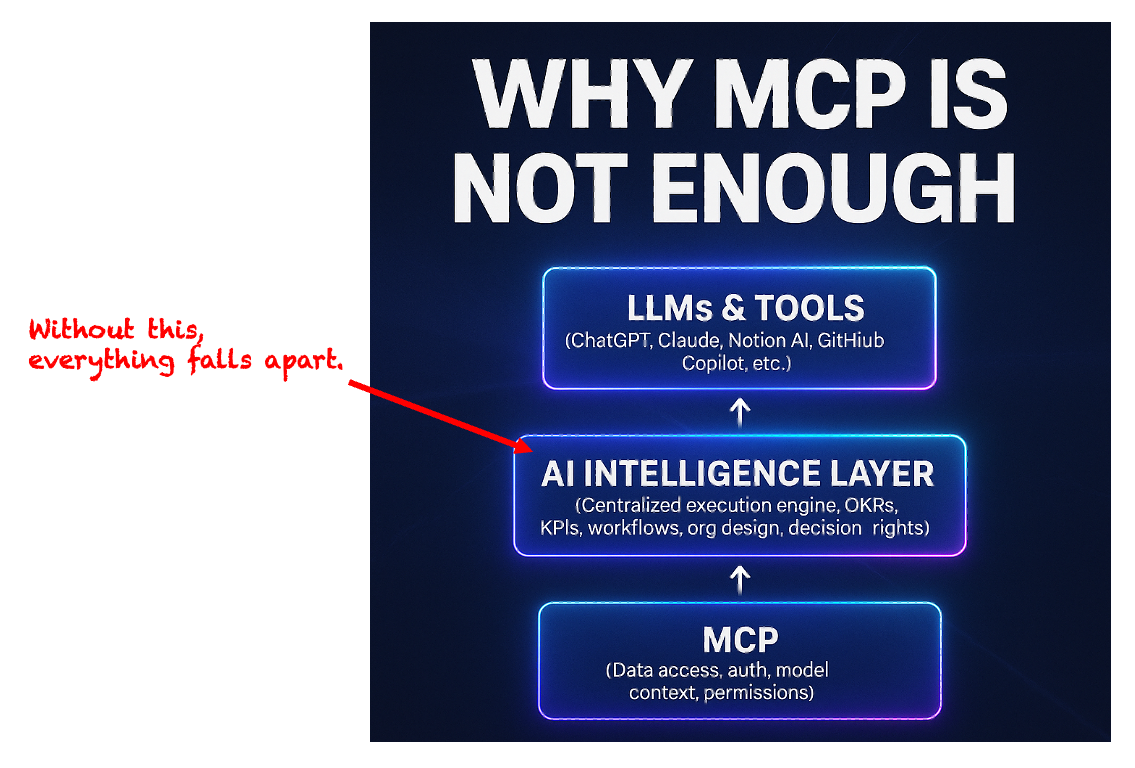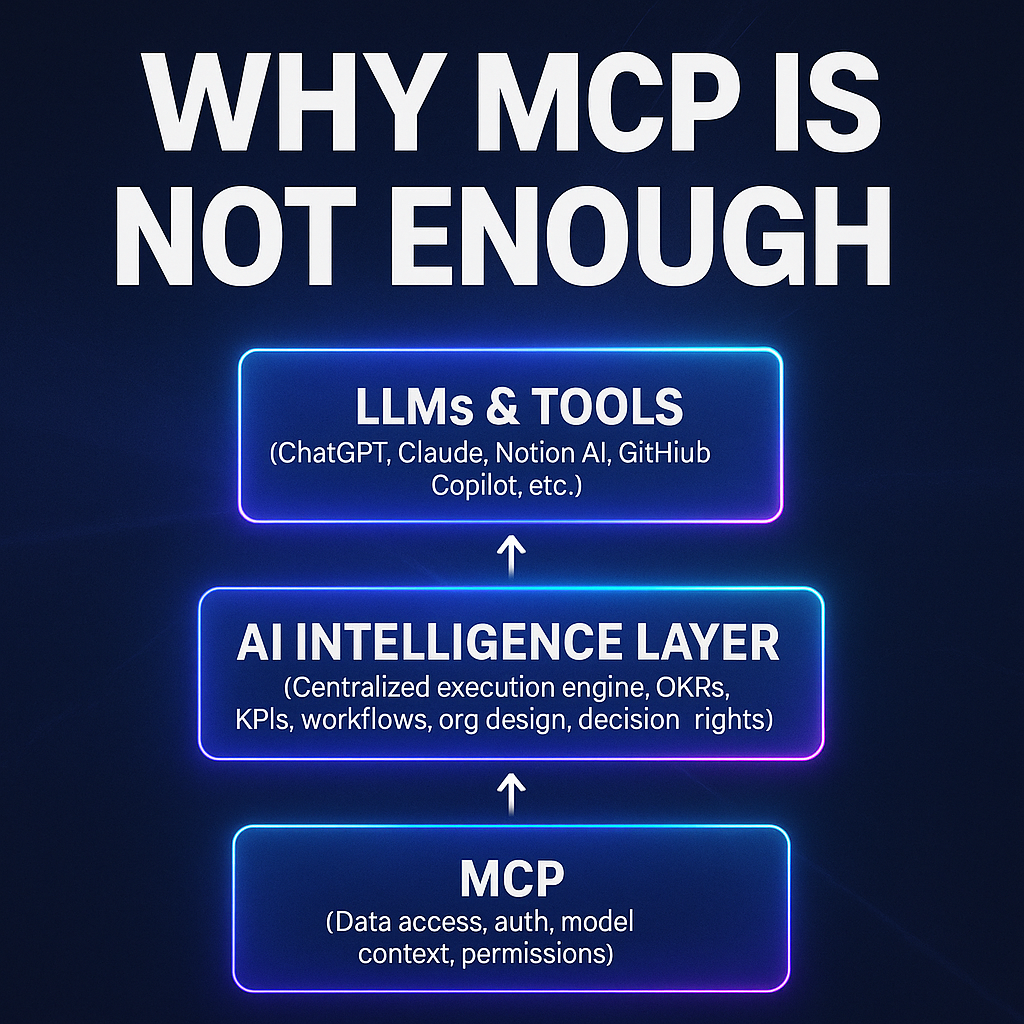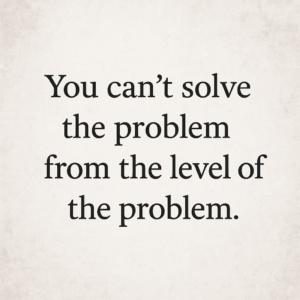Without an AI Intelligence Layer, Your Enterprise AI Strategy Will Fragment, Not Scale
Summary Insight:
Connecting LLMs to your enterprise through MCP alone creates a disconnected, dumb system. To scale with intelligence, you need a centralized execution engine — an AI Intelligence Layer — that aligns every AI action with your goals, people, data, and workflows.
Key Takeaways:
- MCP connects tools and models, but lacks strategic coherence.
- An AI Intelligence Layer creates a digital twin of your company — syncing goals, people, data, and processes.
- Without it, you’re building chaos at scale – not strategic execution.
The False Promise of Plug-and-Play AI
It sounds so easy. Wire up your enterprise data into Model Context Protocol (MCP), hook up a few LLMs, sprinkle in some tools and agents… boom — instant AI transformation.
Except it’s not. What you actually get is a scattered mess of bots making decisions in silos. Each one “helpful” in its own lane, but collectively creating noise, not intelligence.
MCP is necessary — but it’s not enough. If you want your AI systems to drive performance, not entropy, you need more than pipelines. You need a brain.
Enter the AI Intelligence Layer
Think of an AI Intelligence Layer as the centralized execution engine for your company. It doesn’t just route context. It integrates it — aligning all AI output with your strategy, workflows, and org design.
This layer becomes the digital twin of your business. Not just a mirror of your data, but a living, directional map that keeps every AI tool in sync with:
- Who you are
- What you’re trying to accomplish
- Who’s accountable for what
- How your workflows actually function
- Where the friction is
It’s what makes the difference between AI agents behaving like scattered interns… and acting like coordinated team members who know the plan, understand the structure, and push toward the same goal.
The Stack: Done Right
Here’s what a functioning AI enterprise stack actually looks like:

MCP gives your tools access.
The AI Intelligence Layer gives them purpose.
When designed well, this system behaves like a true organizational brain — integrating sensory input (data), memory (context), motion (tools), and intention (strategy).
Why This Matters
Plugging models into MCP without an AI Intelligence Layer is like plugging jet engines into a paper plane. You’ll generate a lot of power, and then watch things tear apart.
- Your tools won’t know how decisions cascade across the org.
- You’ll get duplication, drift, and dysfunction.
- There’s no visibility into what’s working or not.
- Strategy loses traction. Execution gets noisy. The organization wastes energy.
Worse, the illusion of intelligence will delay the realization that the system is broken.
The Missing Link: Organizational Awareness
Here’s the core problem: LLMs today are context-hungry, but company context isn’t just data. It’s intention. It’s people. It’s structure. It’s friction points. It’s dynamic and evolving.
An AI Intelligence Layer brings Organizational Physics principles to the AI layer:
- Energy flow: AI outputs are directed toward strategic goals.
- Entropy awareness: Systemic friction is visible and actionable.
- Emergence support: Feedback loops drive adaptation.
- Accountability & authority: Roles and decision rights push authority to where the work is happening.
- Systems integration: People, process, and data aren’t siloed — they’re integrated for alignment.
The truth is that companies who have already integrated and mastered the principles of Organizational Physics, are really-well set up to integrate the next wave of AI Intelligence to drive strategic execution.
Why FostrAI is Compelling
Former clients of mine, Jason Baxter and Chris Powers of Fort Capital, have recently launched a new AI Intelligence layer service called FostrAI.com. FostrAI wasn’t built as another wrapper for models. It was designed to become your company’s execution brain — ingesting who you are, what you do, and where you’re going. Then powering AI agents to act like insiders, not spectators.
FostrAI aligns nicely with the principles of Organizational Physics and you can sign-up for early access here: https://fostrai.com/.
Before layering in an AI Intelligence Layer, I would make sure that your company has first adopted a framework like Organizational Physics to drive strategic execution. Then AI will amplify what’s working instead of scaling what’s broken. Apply to my Designed to Scale coaching program: https://organizationalphysics.com/ceo-coaching to quickly get your business aligned for AI adoption.
But whether you choose to adopt Fostr or another AI Intelligence layer, the bottom line is that if your enterprise AI doesn’t include a coherent model of your company, it will produce incoherence, not results.
Summary of Why MCP Isn’t Enough
If you want your AI systems to drive performance — not confusion — you can’t stop at MCP. You must architect an AI Intelligence Layer that:
- Connects your people, workflows, and KPIs
- Maps friction and execution gaps
- Aligns every tool, agent, and model to your strategy
Taking this approach is not just smarter. It’s scalable. And it’s the only way to make AI serve your business — not the other way around.




